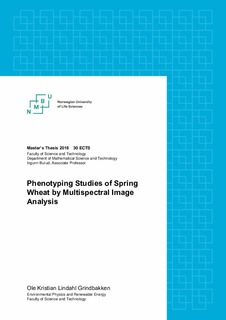| dc.contributor.advisor | Burud, Ingunn | |
| dc.contributor.advisor | Lillemo, Morten | |
| dc.contributor.author | Grindbakken, Ole Kristian | |
| dc.date.accessioned | 2018-09-06T12:35:25Z | |
| dc.date.available | 2018-09-06T12:35:25Z | |
| dc.date.issued | 2018 | |
| dc.identifier.uri | http://hdl.handle.net/11250/2561258 | |
| dc.description.abstract | To meet an increasing demand for food production there is a need for faster genetic gains
in Norwegian cereal breeding through more precise phenotyping. High-Throughput Phe-
notyping (HTP) and genomic selection through multispectral imaging and statistical anal-
ysis offer possibilities of yield gains. Several indices have been tested to indicate grain
yield, such as the Normalized Differential Vegetation Index (NDVI), MERIS Terrestrial
Chlorophyll Index (MTCI) and the Enhanced Vegetative Index (EVI). These indices uti-
lize the difference in reflectivity in different spectral bands. The indices can indicate
differences between healthy plants, stressed plants or non-plants.
The research revolves around 96 plots of 24 historical wheat cultivars and 602 plots of
301 younger breed lines. Both sites planted at Vollebekk research farm at Ås in Norway,
laid out in an alpha-lattice split plot design. The design for the 24 historical cultivars had
two levels of nitrogen (N) fertilization, 75 and 150 kg N/ha, applied at sowing. There
were two replicates of wheat cultivars of each fertilization level. The set of 24 spring
wheat represents the yield progress over the last 40 years in Norway.
Multispectral images were taken in the wavebands green (GRE) (550nm), red (RED)
(660nm), red edge (REG) (735nm) and near-infrared (NIR) (790nm) with a Parrot Se-
quoia multispectral camera combined with a sunshine sensor. The spectral band images
were stitched together using Pix4D software by utilizing GPS coordinates and image fea-
tures. To aid stitching of the multispectral and RGB images, tie point objects were laid
out in the field. Maps of vegetation indices were computed in Python, by forming linear
combinations and ratios of sums and differences in the multispectral reflection. In addi-
tion,3D models and Digital Surface Models (DSM) of the area were calculated from RGB
images using Pix4D, which were used to indicate plant height. All cameras and sensors
were mounted on a light Unmanned Aerial Vehicle (UAV). Images were taken throughout
the season of growth at regular intervals.
The time series of the vegetation indices showed peak values during the period of grain
filling before declining when plants approached maturity. Values where slightly higher for
wheat plots that received a higher dose of fertilization throughout the season of sampling.
By combining the digital measurements with manual measurements of grain yield, kernel
weight, and plant height, the statistical significance of separating cultivars is explored. | nb_NO |
| dc.language.iso | eng | nb_NO |
| dc.publisher | Norwegian University of Life Sciences, Ås | nb_NO |
| dc.rights | Navngivelse 4.0 Internasjonal | * |
| dc.rights.uri | http://creativecommons.org/licenses/by/4.0/deed.no | * |
| dc.subject | Multispektrale bilder | nb_NO |
| dc.subject | UAV | nb_NO |
| dc.subject | Precision farming | nb_NO |
| dc.subject | Vegetation | nb_NO |
| dc.title | Phenotyping studies of spring wheat by multispectral image analysis | nb_NO |
| dc.type | Master thesis | nb_NO |
| dc.subject.nsi | VDP::Matematikk og Naturvitenskap: | nb_NO |
| dc.subject.nsi | VDP::Landbruks- og Fiskerifag: 900::Landbruksfag: 910::Landbruksteknologi: 916 | nb_NO |
| dc.description.localcode | M-MF | nb_NO |

